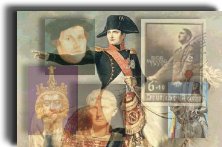
Winter Quarter, 2020
Room: 134 Thomsen Hall
Time: Monday and Wednesday, 1:30-3:20 pm
(5 credits. (I&S)
Office hours: Monday, 11:30 am - 12:30 pm
and by appointment
As in the rest of Europe, the 18th century witnessed the emergence of new intellectual currents during what came to be called the "Age of Enlightenment." Although primary emphasis was on "reason," a religious revival was also sweeping Scandinavia--having begun as a pietistic movement in northern Germany. It was, in many ways, a contrary pre-romantic movement which ran as a counter to the rational emphasis of the time.
Although the French Revolution spread its influence into Scandinavia, revolutionary fervor did not manifest itself. Ideas of liberty and national identity, however, did emerge, most notably in Finland and Norway, which had been satellite states to their dominant neighbors, Sweden and Denmark respectively.
During the 19th century, the Scandinavian countries were most notably influenced by the Romantic movement, a reaction to the Enlightenment and a cultural movement which owed much to the pietistic movement of the early 18th century. During the course of the 19th century, too, social issues emerged to play more prominent roles in people's consciousness and in the political life of Scandinavians.
With industrialization in the latter half of the 19th century came growing popular support for social democracy and an increasing emphasis on economic and material forces determining social and political development. The trend continued into the 20th century influenced by the writings of Karl Marx and the Russian Revolution inspiring Scandinavians as much as they did others throughout Europe. The Scandinavian variety of socialism, however, was largely reformist and evolutionary, not revolutionary.
The 20th century can perhaps be characterized as the century of social democracy and the welfare state in Scandinavia. Based on strict concepts of political and economic equality, the century gave political voice to the working classes, the so-called "proletariat." The trend, by and large, continued into the final decades of the 20th century as the Scandinavian countries sought to articulate "a middle way" between the communist totalitarian regime of the Soviet Union and the capitalistic liberalism of the United States. The Scandinavian states remain, in the first decade of the 21st century, a moderate blend of state ownership and private capital balanced and functioning within the context of parliamentary political democracies.
In Post-Cold War Europe, the Scandinavian states have softened their posture of Nordic unity to focus increasingly on European integration. Finland, Sweden, and Denmark, have become members of the European Union, while Norway and Iceland have maintained a reserved, and a somewhat ambivalent, distance. In the Baltic states, a new reality exists with the disappearance of the Soviet Union as they look increasingly to the European Union and NATO as economic and political partners. Both Scandinavia and the Baltic states are in the process of redefining their roles as they navigate their way through the beginning years of the 21st century.
First Exam (Date: TBD)

Second Exam (Date: TBD)
Third Exam (See final exam schedule)
Copyright © 2016-18 Department of Scandinavian Studies, University of Washington, Seattle, WA 98195-3420